What You Get in Tokyo for $1,800/Month
What is a typical 1-bedroom (1LDK) apartment in central Tokyo actually like? My approx. $1,800/month apartment in Setagaya, Tokyo.
Tokyo is one of the world’s major cities and one of its biggest.
There are more than 37 million people in the greater metropolitan area, almost 14 million in the city proper, and Tokyo has the biggest economy of any city in the world. It’s safe to say that space comes at a premium.
Just like my previous $950/month Tokyo studio apartment, you will either find this $1,800/month 1-bedroom apartment expensive or a good deal, depending on where you’re from.
The location
As with anywhere, the location has a lot to do with the price. The metropolitan area of Tokyo is made up of 23 wards, and each operates with some autonomy. Because of this, each has slightly different residential taxes and average rent prices.
In fact, when comparing average rent prices between the cheapest and most expensive wards, the most expensive (Shibuya ward) is more than double the cheapest (Katsushika ward).
The average rent for a 1LDK (1-bedroom apartment) in central Tokyo (within the 23 wards) is said to be about ᆬ145,782 or $1,458 per month in 2022 [J].
Ward: Setagaya
My apartment was in the Setagaya ward which is west-southwest from the center of Tokyo. It has just under 1 million residents and is the second largest ward in Tokyo in terms of area. Its residential taxes and rent prices, while generally cheaper than others wards like Minato or Shibuya, is slightly above average.
The most well known area in Setagaya is probably Shimokitazawa, an area known for its subculture, thrift stores, small bars and live houses, and a spot where many performing artists get their starts.
This apartment is about 3 minutes from there by train.
Station: Kyodo
My wife and I chose an apartment in Kyodo [MAP] - a residential area about 15 minutes from Shinjuku and Shibuya.
There is one train line that goes to Kyodo - the Odakyu line. The Odakyu line goes from Shinjuku all the way out west to the Hachiōji area and down to Kanagawa prefecture.
The station and train lines that go through it are important factors when deciding where to live in Tokyo, and it also affects the price.
At Kyodo Station, the regular and express trains stop, which makes it more desirable. The rapid express train doesn’t stop, however.
There are also some trains that become Chiyoda line trains. Personally, I think that the Chiyoda line is one of the best lines in Tokyo because it goes to popular areas such as Harajuku, Omotesando/Aoyama, Nogizaka (right next to Roppongi), Hibiya (next to Yurakucho and Ginza), Nijūbashimae (Marunouchi and Tokyo Station area).
It was also easy for me to get to work, taking around 40 minutes door-to-door with 1 easy transfer on the same platform or none at all.
Our apartment was only a 5 minute walk from Kyodo station. Around the station area, there are about 3 supermarkets, dry cleaning, convenience stores, a gym, and other food places and coffee shops.
It’s also worth noting that Gotokuji and Yamashita station are only about 10 minutes away, making the Setagaya line also accessible.
The apartment building
The apartment building is an 11-story concrete building built in 2010. In Japan, they refer to this type of apartment as a “mansion”, which tends to be more expensive to rent when compared to “apāto” types.
It’s a corner unit which is nice, but there wasn’t anything special about the view. It faces west and looked down at a main street below, and if you look around the corner, you can see the Shinjuku skyline in the distance.
Key features
“Auto-lock” - A secure entry system into the building (there’s actually 2 to get in)
Security camera system in the lobby and elevator
Video intercom to allow people into the building
Front desk/concierge service
Delivery boxes - A self-serve, secure locker system for box deliveries in case you’re not home
Courtyard area outside of the lobby
Car parking garage (extra fee) - A covered parking lot meet to the apartment building
The building is located next to the train tracks, so it can be a little on the noisy side when you’re outside. The apartments are equipped with double-paned glass so almost all of that noise is filtered out.
To the front of the west side of apartment is a gym, and the other side faces a street.
The apartment complex is owned by Odakyu, the same company that runs the train lines, has department stores and a lot more. They also run the promenade that leads up to the building from Kyodo station.
The building has staff and a concierge that helps out with tasks such as mailing boxes, getting dry cleaning done, etc., however they come at an extra fee. The staff are really nice though.
The entire area, including the apartment building, are very well maintained by the Odakyu staff. They’re always cleaning, doing landscaping, and even worked through the night on a snowy night to clear the ice.
The apartment
This apartment is classified in Japan as a 1LDK, which means 1 bedroom, a living room, dining area, and a kitchen.
Key features
47.15 sq. m (506 sq. ft.)
Stove with 3 gas burners, grill
TOTO toilet with remote bidet, heated seats, etc.
Bathroom with anti-fog heated mirror cabinet
Flat-floor shower and a tub that automatically fills, reheats and circulates water while maintaining temperature
Dryer function that allows clothes drying in the shower
Washing machine hookup with hot and cold water
2 AC/heater units (1 in living room, 1 in bedroom)
Large balcony with open-air view
2 sliding doors with double-paned glass
Higher than typical ceiling
Fees and costs
The monthly rent totaled to ¥180,000 or about $1,800 USD, depending on the exchange rate. This included the management and service fee of ¥7,000 ($70). When looking at the monthly costs, it’s pretty reasonable considering the size and density of the city, and quality of the apartment itself.
The initial costs, however, were a bit high as often is the case.
Initial costs
While exact costs may vary depending on the rental agency, it is typical that there will be a deposit and “key money” amongst a few other smaller fees. The key money is what was a bit different from any rental experience that I had.
There’s also the typical and non-refundable “thank you” fee to the property owner for letting us rent, it’s paid at the beginning of each contract term. This means that you’ll pay it again if you choose to stay at the location and renew for another 2 years.
Personally, I think it’s a ridiculous fee, especially if you’re a good renter because you’re the one actually helping the property owner out, but that’s the norm in Japan.
They take out a cleaning fee from the deposit when moving out.
My initial moving-in expenses were something like this:
Deposit: ¥180,000 (1-month’s rent)
Key/thank you money: ¥180,000
1st month’s rent: ¥180,000
Key fee: ¥22,000
Insurance: ¥10,400 (1/year)
Total: ¥572,400 (approx.)
It’s also worth mentioning that in Japan, the tenant is responsible for providing their own appliances.
This includes things like refrigerator, washing machine, and light fixtures. Luckily, electronics stores have sets for sale and you can find appliances at reasonable prices.
Utilities
The rent didn’t include any utilities.
Our monthly utility bills on average for 2 people were something like this:
Electricity: ¥5,576 (depending on season)
Gas: ¥4,804
Sewer & Water: ¥6,975 (once every 3 months)
Internet: ¥4,734
Total: ¥22,089/month (approx.)
I wrote more about utility costs in Tokyo here.
This may total to be more than a lot of other cities around the world. However, to get to live in one of the best cities in the world, a huge one at that, was worth it.
Check out more in Tokyo.
Keep in touch:
Street Photography: Gotokuji & Kyodo, Tokyo
Going out on a snowy winter day to take street photos of Gotokuji and Kyodo, Tokyo.
Gotokuji and Kyodo, Tokyo, are two neighboring areas in Setagaya Ward. The famous “maneki neko” temple is in Gotokuji, and Kyodo is home to a university, some schools and a larger station
It began snowing heavily for Tokyo one winter day in 2022, and I decided to go our with my camera and make a video while I took some street photography.
I also made a video of myself taking these photos that winter evening. Please watch if you’re interested:
Keep in touch:
Street Photography: Koenji, Tokyo
Shooting street photos of Koenji, Tokyo, a neighborhood known for its alternative subcultures.
The area of Koenji, Tokyo, is considered by locals as one of the coolest neighborhoods in the city. It’s best known for its alternative subcultures, and on a late fall afternoon in 2021, I decided to go there for some street photography.
I also made a video of myself taking these photos that day. Please watch if you’re interested:
Keep in touch:
Tokyo Olympics 2020: What it's Been Like Living in Tokyo
My experience living in Tokyo as it prepares for the Olympics and fights the Covid-19 pandemic.
When Tokyo was announced as the location for the 2020 Olympics, it was a huge deal.
It represented the return of Japan to the forefront of the global stage, it turned Japanese words like “omotenashi” into marketable slogans, it further invigorated the push for foreign tourism, sparked new businesses, renovations and developments eying the year.
Ultimately, it gave hope to country that was being called stagnant.
Truth be told, I love the Olympics.
The Dream Team, Kerri Strug landing, Apollo Anton Ohno, Usain Bolt, Vince Carter’s massive dunk, Mosely on the moguls, Michael Phelps, the men’s swimming relay comeback, Beijing’s mind-blowing opening ceremony, Rikako Ikee’s coming back from leukemia. All of it.
I like seeing people from around the world who are at the top of what they do, come together and compete, and let me feel excitement and sense greatness in sports - most of which I would never watch or even know about if it weren’t for the Olympics.
I had always wanted to see the Olympics in person.
A friend and I talked about wanting to drive up from San Francisco to Vancouver for theirs. So of course when I was sitting in my apartment in Fukuoka watching the TV and “Tokyo 2020” was announced, it was just such a big thing. I’d have to stay a long time more in Japan, but I had a chance to live in the host country. I set this arbitrary date that I’d try to be in Japan at least until then.
So of course, when tickets became available, I had to try and get some.
Olympic Ticket Lottery
The process was tedious. You had to go on a site, to make an account that allowed you to go to another area to TRY to buy. For the first site, just to get in it said I was about the 900,000th person waiting to even make an account.
Finally after a few hours I got in, had to receive an automated phone call to confirm my identity, and then I could apply for tickets.
You could apply for up to 30 tickets, so if you’re going with another person, that’s 15 events. But for each event, you had to choose things like if it’s a medal round, what seating section you’re applying for - and of course these prices varied. It was a lottery.
And then the results came in.
Many in Japan were pissed because very few people got tickets and it seemed like there was more preference for foreigners. But my wife and I lucked out - between the two of us, we got 3 events, pretty good ones too. We got 2 medal round swimming events and 1 men’s basketball semifinal.
We had the option to buy, and they were not cheap. The basketball one was around USD $100 per person and swimming was about USD $700 per person. But we thought, it’s a once in a lifetime experience, so we bought all of them knowing we had the option to sell one back later.
But then the pandemic hit.
Tokyo’s Olympic Problems
The Tokyo Olympics had a lot of problems from the start.
There we’re rumors of inside deals, the logo being stolen, issues with the Zaha Hadid designed stadium and its replacement, Yoshiro Mori and his sexist comments, the shadiness of celebrated choreographer MIKIKO being pushed out after she designed the opening ceremony and replaced with someone who made rude remarks about Naomi Watanabe, the musician who bragged about severe bullying, the other who joked about the Holocaust…
You get the point.
Questionable handling of Covid-19
As Olympic problems mounted, Japan’s handling of the virus continued and is still getting mixed reviews.
Emergency declarations
There have been 4 emergency declarations in Tokyo.
Without the legal power to completely lockdown, these declarations have been largely focused on restricting night life - from closing shops early to banning alcohol sales. More recently, rules labeled as silly such as no drinking after 8PM or being only able to drink by yourself have been introduced.
Each time these declarations are lifted, the situation gets worse, and while the first 2 helped decrease people out and about, the last two haven’t really done anything.
It seems like people are a bit over the silliness.
Slow and tedious vaccine rollout
And while this was going on, in the critical months leading up to the already postponed Olympics, there’s a super slow vaccine rollout and just a lot of mixed messaging.
We have concerts and events being cancelled, businesses being asked to close early, and we have a push to bring in thousands of people from around the world for the Olympics.
Meanwhile, I finally received my voucher to qualify me to get the vaccine last week in mid-July. The actual timeline of getting the first jab however is September.
Olympics or Covid-19?
Of course all of this makes it look like the government has their priorities mixed up and isn’t acting in the best interest of their people.
It’s no surprise that there’s a lot of people pretty vocal about how crazy this all is. There’s been talk about the incompetence of the government and how it’s all about the money… Dentsu.
I too think that holding the Olympics during this situation is kind of nonsense.
The decision to do or not do the Olympics is not that simple.
We don’t really know all the details, however. If you look back at Twitter, you’ll find that people already had strong opinions for a while just based off of headline reading and mixed frustrations only to have new information come out later. And while the new information may not sway opinions, it does point to the fact that we still don’t really know everything other than it’s stupid and that the IOC is looking like a bunch of assholes.
One thing we overlook is the fact that the the government isn’t just one thing. There’s a lot of internal arguments going on.
For example, Olympic-related events were planned in various wards around Tokyo, but some ward governments were refusing the metropolitan government because of the potential liability.
And Dentsu… it’s easy to hate Dentsu, the agency that’s associated with “Karoshi” - death by overwork and Olympic greed.
But there’s not all that much talk about the small businesses that depend on work from them. Dentsu doesn’t put boots on the ground, it’s a lot of outsourcing to small and medium sized companies who then outsource to even smaller companies, freelancers and artists.
Those people are the ones whose livelihood depends on these kinds of projects.
If you’ve visited Tokyo in the past few years, you might’ve noticed a lot of the construction and renovations going on. There’s a lot of new things made for or at least made with the Olympics in mind. And their stopping or cancelling are bound to have an impact.
It’s just an unfortunate overall
Especially with this being such a huge event that was portrayed as a pivotal moment for a country, you can’t help but think that things would’ve been handled just a little bit better to make sure it happens in the best way.
Hope things will go well. If you want to watch my video on this, please check it out.
KEEP IN TOUCH
SHARE
Springtime Walk in Shimotakaido, Tokyo
Exploring the streets of Shimotakaido in Setagaya, Tokyo during cherry blossom season.
The Shimotakaido area of Setagaya, Tokyo, is a smaller, residential area with a few schools in the neighborhood. The main area is lively with a variety of shops and eateries, and its tunnel of cherry blossoms make for a nice walk during the springtime.
Keep in touch:
Working From Home in Tokyo
A look at working from home in Tokyo, as the city is now in a quasi-lockdown and tries to reduce person-to-person contact by 70%.
Unfortunately, shortly after I talked about Tokyo being in a mystery situation regarding COVID-19/Coronavirus, cases spiked.
The situation in Tokyo (as of April 2020)
The country declared a state of emergency in early April. Apparently, the law forbids the government from enforcing a full lockdown, so Tokyo and several other prefectures are in more of a quasi-lockdown, with the government firmly requesting adjustments to business and working from home.
The goal is to cut person-to-person contact by 70%.
While many non-essential workplaces have abided, some haven’t.
Luckily, my company has had a work from home option since the beginning of March.
What I do
I work at a marketing agency, TAMKO, and most of the projects I’m on are with international clients so I’m never in physical meetings with them anyway.
Even on regular office days, it’s common for my teammates or myself to not always be in the office, so communicating through chat or video conferencing is already something we’re used to.
The daily routine
The majority of our communication happens over Slack. To clock in, we type one of several messages and it’s recorded automatically. Most people use “おは” (oha) which is short for ohayogozaimasu, or “good morning.”
Almost all communication happens in Japanese.
I go about my day checking and replying to emails (we use Gmail), working on client projects as well as internal ones, and having an occasional meeting or virtual team lunch.
For lunch, I try to make something simple or eat leftovers, but sometimes there’s nothing or I’m lazy.
My usage of Uber Eats has gone up quite a lot.
I’m not alone, apparently.
The app has recently been in Japan’s top 5 of the App Store’s free app rankings, and has gotten additional exposure by people like celebrity Tsubasa Honda, who recommended the service in a YouTube video that got 1.8M views in a little over a day.
I’ve been watching a lot of YouTube while I eat lunch. I tend to watch videos where I can learn something from, videos from channels like CNBC, Vox, Gary Vaynerchuk, Business Insider, some vloggers and so on.
Amazon has also been pretty great.
For the most part Amazon deliveries have been so far unaffected by the situation.
Amazon Prime deliveries in Tokyo are really fast, sometimes within 12 hours if you order the night before.
My apartment also has a delivery box system in case we aren’t home or able to get our deliveries when they come in. It’s been helpful as we order online a lot, especially during this time.
About twice a week, we have an all-hands team meeting. We were using Google Hangouts but have more recently switched to Zoom for these.
If you’d like to see a day in motion, feel free to watch the video I made.
Otherwise, I hope everyone is doing as well as can be.
KEEP IN TOUCH
SHARE
A Snowy Spring Day in Tokyo
Photographing the streets of Setagaya, Tokyo on a snowy, spring day.
2020 has been an interesting year to say the least.
Amongst the odd occurrences was Tokyo getting its heaviest snow day of the season. The catch? It was in late March, after the cherry blossoms were already out.
Snow fall in the city is one of my favorite conditions to photograph, so I walked around the Kyodo area of Setagaya, Tokyo on this day.
KEEP IN TOUCH
Life in Tokyo During the Coronavirus Pandemic
How it’s like living and working in Tokyo during the COVID-19 / Coronavirus pandemic.
Not much panic has been seen so far, supermarkets are fine but some items are out of stock
Big changes for me include optional remote work, but many companies are business as usual
There seems to be little social distancing, but Japanese cultural norms may help a little
Japan was one of the early countries to see COVID-19 / Coronavirus cases boom. The cruise ship Diamond Princess was quarantined just south of Tokyo in Yokohama Bay and others got it from a taxi driver in the city.
The government then canceled school, graduations and school entrance ceremonies. (The school year ends in March, starts in April)
So how is life now in one of the early Coronavirus hot spots?
THERE HASN’T BEEN MUCH PANIC, BUT THERE ARE SHORTAGES
From videos of Costco rushes to brawls over toilet paper, it seems that there’s considerably more panic occurring outside of Japan.
Masks have been sold out for weeks now, however, toilet paper and tissues are scarcely found, and soaps and hand sanitizers are low on stock. The rest of the items in the supermarkets are fully stocked as usual.
This lack of panic is something that Japan has been quite good at, albeit access to necessities are currently problem-free.
Could it be naivety and having too much faith in the good infrastructure? Maybe. But even after the 2011 Tohoku earthquake and tsunami, people lined up for supplies and rations despite questionable government response, a far cry from the reports of looting during the Hurricane Katrina aftermath due to a failed response.
Tokyo likely would be different, however.
There is debate on the actual number of infected, though, and Japan seems to be under-testing.
Theories as to why range from limited testing capacity to Japan being good at treating pneumonia, to autopsies not being typical, to a desire to maintain the perceived ability to host the 2020 Summer Olympics.
I’m not knowledgeable on testing, so I can’t comment much on it, but people have said hospitals are denying those with fevers for reasons such as not having traveled abroad.
THE BIGGEST CHANGE FOR ME IS THE SHIFT TO Optional Remote Work
My company implemented optional remote work starting at the beginning of March and has been deciding its continuation on a weekly basis. The goal is returning at the end of the month.
Even though this option has been given, there seems to be several staff members in the Tokyo office each day. Part of the reason some are in the office or on the move is due to client requests.
While some companies in Tokyo have IMPLEMENTED remote work, others are struggling to adapt or haven’t at all.
With no demand by the government, companies are deciding courses of action on their own, and they seem to be quite varied. Of course, there are huge concerns about people not being able to afford their living expenses if they’re out of work for a while, but the following are also likely reasons many are slow to implement adjustments.
The first potential reason is outdated work culture and policies.
As some know, many Japanese companies tend to have outdated work cultures in place. This includes overvaluing the amount of time employees are physically in the office. Policies or tools that allow employees to work remotely probably aren’t set up.
A colleague of mine tried to switch a meeting to an online one, but the reply said that while their party considered it, they’d rather keep it face-to-face.
We work in marketing by the way, so in-person meetings are not exactly necessary.
This email was from a municipal government office despite the Prime Minister encouraging social distancing, so it’s hard to expect private companies to do any different.
Another possible reason for lack of remote adoption is low tech literacy.
Despite Japan having a high-tech image, tech-oriented businesses often suffer from slow domestic market adoption. Smartphones, for example, are only used by 74% of Japanese as of 2019, lower than most major countries. For reference, that number is 88% in the UK, 91% in Australia and 92% in South Korea. [J]
If that gives us a glimpse of the situation at some schools that were mandated to go online, imagine that at the corporate level.
Older employees in particular may not know how to work remotely and take part in an online meeting if they have to do it themselves. This is likely a challenge companies need to overcome.
The third possible reason is low concept of social responsibility.
I’ve noticed that outside of sales, profits and losses, and other easily measurable data points, things such as brand building, public relations, human resources and social responsibility have not become a big thing yet in Japan.
It doesn’t mean they have ill intent by any means, they’re just slower to mobilize and be proactive when it’ll mess with their normal procedures and balance sheets.
If the App Store is any indication of people moving to remote work, Japan doesn’t seem to be in a hurry.
Some companies have yet to make any announcement about the Coronavirus to their employees.
I’ve also heard of people showing up to the office despite having a fever due to the Japanese concept of gaman (perseverance) and their fear of judgment from others.
THERE’S LITTLE INCREASE IN SOCIAL DISTANCING
I’m just as guilty of it since I was out in busy Harajuku, Tokyo, for an errand recently. I will say though, looking around, you wouldn’t really guess there was a global pandemic going on.
It did seem a tiny bit less crowded, but the most noticeable difference was a lot fewer foreign tourists.
Trains seemed pretty full as well, sometimes with groups going out as shops and restaurants by and large still remain open.
Cherry blossom season has just started, which is bad timing since it will likely draw larger than desired crowds.
A few cultural norms may help Japan a little in this situation.
While there’s debate on whether or not masks protect at all, it’s said they may help prevent infected people from spreading the virus. Luckily, mask-wearing is normal in Japan.
I noticed more people wearing masks in late February than I do now, though, but I feel that’s likely due to a supply shortage than anything else.
Another cultural aspect is that compared to many other cultures, Japanese don’t touch each other during greetings and interactions. They’re actually very hands-off - they bow rather than shake hands, and they don’t hug or kiss.
On trains, talking (loudly) is discouraged.
Overall, Japanese tend to be pretty clean. Anyone who has visited the country likely noticed this simply from walking the streets or using public facilities.
Looking forward, Tokyo has two outcomes
One can only guess what will happen, but either Tokyo is a ticking time bomb or it somehow escapes. Hopefully the latter.
KEEP IN TOUCH
SHARE
Typical Workday Lunch Costs in Tokyo
What my typical lunches on Tokyo workdays are like and how much they cost.
Workday lunch costs in Tokyo are pretty reasonable. This is coming from the perspective of an American who has lived in major US cities.
The average cost for weekday lunches in central Tokyo is about ¥822/day, or about $7.58 USD/day.
According to a survey, 89% of Tokyoites average under ¥1,000/day, or less than $9.09 USD/day.
33% keep it under ¥500/day, or less than $4.55 USD/day. [J]
It’s not because they’re eating bad food or barely eating anything either. There are just a lot of affordable options, including going to one of Japan’s top notch convenience stores.
I decided to test this out.
To be honest, I don’t have a strict lunch budget set, and I just go with how I feel that day. I kept track of a week of my unplanned workday lunches, eating as I usually would.
Here’s where I went and how much it cost.
Kitaka Shokudo
A casual ramen shop whose style falls in the “Chuka soba” category, or Chinese soba. The broth is mainly soy sauce based, and the bowl is topped with pork.
Cost: ¥750 (~$6.83 USD)
MAP
Note: The bowl pictured above is a higher grade than what I had this week and costs ¥950 (~$8.64 USD)
Sutadonya
This is a fast food “donburi” chain, which is basically meat on rice. More popular chains in the category include Yoshinoya or Sukiya, but Sutadonya is known to have bigger portions, be really flavorful and utilize a lot of garlic. Note: Eggs are a staple in the Japanese diet and eating raw eggs are safe in Japan.
Cost: ¥630 (~$5.74 USD)
http://sutadonya.com [J]
MAP
Ethiopia
Due to working in the Kanda area of Tokyo, there are a lot of good curry shops. It’s the curry capital of Tokyo, and Ethiopia is one of the famous ones. Their main location is this 2-story, hole-in-the-wall, and sometimes people will line up just to try it.
Cost: ¥920 (~$8.38 USD)
https://www.ethiopia-curry.com [J]
MAP
Xinglong (Koryu)
Taking out and eating at our desks are common in my office. I tend to do this a couple times a week, either choosing foods from a convenience store (aka “conbini”) or going to a nearby restaurant for takeout. This Chinese shop is run by Chinese, and sells pretty decent combination places.
Cost: ¥500 (~$4.55 USD)
MAP
Menya Kokoro
A small chain, Menya Kokoro is known for its Taiwan mazesoba. Oddly originating in Nagoya, Japan, Taiwan mazesoba is a soupless ramen using thick noodles in a strong sauce with flavors like dashi and garlic. It’s topped with condiments like chives, minced meat and raw egg.
Cost: ¥850 (~$7.74 USD)
https://www.menya-cocoro.com [J]
MAP
What was the total cost of lunches for the week?
In this particular week, which I would call is a typical week, I averaged ¥730/day, or about $6.63 USD/day.
My total spend for the week was ¥3,650, or about $33.16 USD.
It’s good to keep in mind, of course, that not every area is created equally. Like Shinjuku or Shibuya, I’m blessed to be working in an area with a lot of affordable food options. Some areas have fewer options or are more expensive on average.
What do you think, all things considered, it’s pretty reasonable right?
PS: I’m sorry if this lowered your food stipend for your Tokyo work trip.
Keep in touch:
What New Years in Japan is Like
Spending the full New Year’s holiday in Tokyo for an authentic Japanese New Year’s experience.
Drinks, countdown parties and fireworks are probably some of the thinks you think about when it comes to New Years. This isn’t really the case in Japan, though.
New Years in Japan can generally be summed up into three words: Eat, drink, pray.
I’ve experienced the turn of the year in Japan a few times since living in the country, and for 2020, I spent the entire New Year’s holidays in Tokyo. I was able to experience what New Years is actually like for a typical Japanese person.
New Years in Japan is a time where the family gets together, and it features a lot of cultural traditions.
It starts off with food being prepared and traditional decorations being put up. Supermarkets open a lot of shelf space for this as everyone prepares for their family gatherings. People make their way back to their hometowns, businesses shut down, and the most relaxing time of year in Japan begins.
NEW YEAR’S EVE
Toshikoshi soba
On New Year’s Eve, we had toshikoshi soba, a buckwheat noodle dish that’s to be eaten just before midnight.
It’s either dipped in sauce or eaten as a soup, which is how we ate it. Our broth was shoyu or soy sauce based and topped with slices of duck and yuzu citrus zest.
Midnight
When the clock strikes midnight, nothing much happens.
The vast majority of Japan has no fireworks show as fireworks are generally considered a summertime activity. There’s no champagne-popping, no toasts, high fives, no kissing.
During my first experience, I was completely shocked at just how calm it was.
NEW YEAR’S DAY
New Year’s Day starts off just as quietly.
Neighborhoods are silent, even in Tokyo, until areas near a shrine or temple. Japanese make their way there for hatsumode, which is the first shrine or temple visit of the year.
Hatsumode
The lines to pray can be really long. We went on New Year’s Day, but the line went out of the shrine grounds and wrapped around the block so we gave up and ended up going to a smaller shrine a couple days later.
Pictured above is hatsumode at Kanda Myojin Shrine near Akihabara, Tokyo. People will do a short, ritual prayer for the new year.
Usually, people will throw in 5 or 50 yen coins - ones with holes in them - ring the bell, bow, clap twice, pray, then bow again.
Otoso
We later did otoso, the ceremonial drinking of nihonshu, better known as Japanese sake.
It’s poured into special ceremonial Japanese lacquerware, traditionally seeped with several herbs, and drank to help keep healthy over the course of the year.
Ozoni
We also made and ate ozoni, a traditional mochi soup that Japanese eat on New Year’s Day.
The broth differs by region, but Tokyo’s is soy sauce based and it’s that type that we had. When I lived in Fukuoka prefecture, it was miso based.
A lot of Japanese-Americans keep this tradition in the US, and I’ve had this for New Years growing up in Hawaii as well.
In Hawaii, we’d also make our own mochi, but I don’t know anyone in Japan that does this anymore. Manually pounding mochi is even more rare, and it’s usually only done as a performance these days.
The vegetables for the soup, such as carrots that are darker red and daikon radish, are cut in great detail. I haven’t seen this level of emphasis in presentation outside of Japan. Better yet, the soup tasted just as good as it looked.
Osechi Ryori
Osechi is thought of as the main New Years food in Japan. Resembling a big, fancy bento box, it’s served traditionally prepared days in advance and served cold to everyone in the family. Most of the foods in it have some sort of meaning to them.
It’s traditionally made at home, but the process is incredibly time-consuming as it’s a lot of different dishes to make. Many don’t have that kind of time these days or don’t know how to make it, so a lot of people buy their osechi dishes from places like department stores.
There’s actually more food in there than it appears, so it does last for a while, but osechi is expensive, generally costing between a few hundred to a thousand dollars.
Nengajo
We briefly went through some nengajo, or traditional New Year’s greeting cards.
Friends, families and business partners send them out each year, but it’s a tradition in decline (about -11% YoY) as less and less people are doing so these days.
POST NEW YEAR’S DAY
The next day, we finally made it to hatsumode at a smaller, local shrine after giving up on January 1st.
Omikuji
At these shrines, you can buy omikuji, which are good luck fortunes.
While I used to get these, I haven’t in the past couple years or so. If you get a good fortune (daikichi is the best), you keep it. If it’s not, you can tie it up on a tree at the shrine so the bad luck doesn’t follow you home.
Takoage
We later went for a walk and strolled through a local park. There were a couple of people doing takoage, or flying a kite. This is another traditional New Year’s activity, but apparently barely anyone does it anymore.
New Years in Japan means family and relaxing.
Almost everything shuts down, letting everyone just sit around, enjoy each other’s company, and just be for once.
It might be frustrating or boring for people traveling during this time, but for residents, especially those in Tokyo, it’s nice to have life slow down for a little.
KEEP IN TOUCH
SHARE
Hanazono Shrine Torinoichi Festival
Shooting around Hanazono Shrine’s Torinoichi Festival in November 2019.
The Torinoichi Festival happens two or three times each November. Hanazono Shrine in Shinjuku, Tokyo, is one of the hosting shrines, and some 600k people take part in the festivities.
People go to buy kumade, which are ornamental rakes, because it’s said that it will help them “rake” in good luck.
I just happened to stumble in during my first year living in Tokyo, but this time I intentionally went to check it out. Unfortunately the crowds were way too much - a line about a traffic lane and a half wide worth of people that went down the street and around the block.
Despite this, there was a lot to see. Here are some scenes I managed to snap.
KEEP IN TOUCH
SHARE:
What You Get in Tokyo for $950/Month
What is a typical studio apartment in central Tokyo actually like? My approx. $950/month apartment in Setagaya, Tokyo.
Tokyo tends to have an image of being expensive. What we consider as expensive or cheap is relative, but if you’re from any major city in the US or Canada, you’ll likely think that renting in Tokyo is a pretty good deal, at least regarding the monthly costs.
As you could guess by the title, my rent for my first studio apartment in Tokyo was about $950 a month.
The location
As with anywhere, the location has a lot to do with the price. The metropolitan area of Tokyo is made up of 23 wards, and each operates with some autonomy. Because of this, each has slightly different residential taxes and average rent prices.
For reference, the average rent for a 1K studio in central Tokyo (within the 23 wards) is said to be about $870 in 2019 [J]. It’s not uncommon to pay a rent within the $700 range for a good place, however.
Ward: Setagaya
My apartment was in the Setagaya ward which is west-southwest from the center of Tokyo. It has just under 1 million residents and is the second largest ward in Tokyo in terms of area. Its residential taxes and rent prices, while generally cheaper than others wards like Minato or Shibuya, is slightly above average.
The most well known area in Setagaya is probably Shimokitazawa, an area known for its subculture, thrift stores, small bars and live houses, and a spot where many performing artists get their starts.
My apartment was about 10 minutes from there.
Station: Shimotakaido
I chose an apartment in Shimotakaido [MAP] - a residential area within 15 minutes of Shinjuku and Shibuya.
Two train lines go to Shimotakaido - the Keio line and the Setagaya street car line. The Keio line goes from Shinjuku all the way out west to the Hachiōji area. The Setagaya line connects Shimotakaido with Sangenjaya.
This area was very convenient for me because the Keio line connects to the TOEI Shinjuku line. This meant that I only had one easy transfer crossing the platform at Sasazuka Station, and sometimes none at all, to get to work which was around 35 minutes door-to-door.
My apartment was only a 3 minute walk from the station. The majority of the walk was along the main road with a 24-hour supermarket, dry cleaning service, Lawson and 7-11 convenience stores, and a lot more along the way. Extremely convenient.
The apartment building
The apartment building was a 12-story concrete building built in 2004. In Japan, they refer to this as a “mansion” (odd, I know). At the time I rented it, it was about 10 years old.
To the west, it had a view of Mount Fuji, and to the east a view of the downtown Shinjuku skyline.
Key features
“Auto-lock” - A secure entry system into the building
Security camera system in the lobby and elevator
Video intercom to allow people into the building
Delivery boxes - A self-serve locker system for box deliveries in case you’re not home
Secure bicycle parking (extra fee)
Mechanical car parking (extra fee) - A parking system that elevates cars to save space
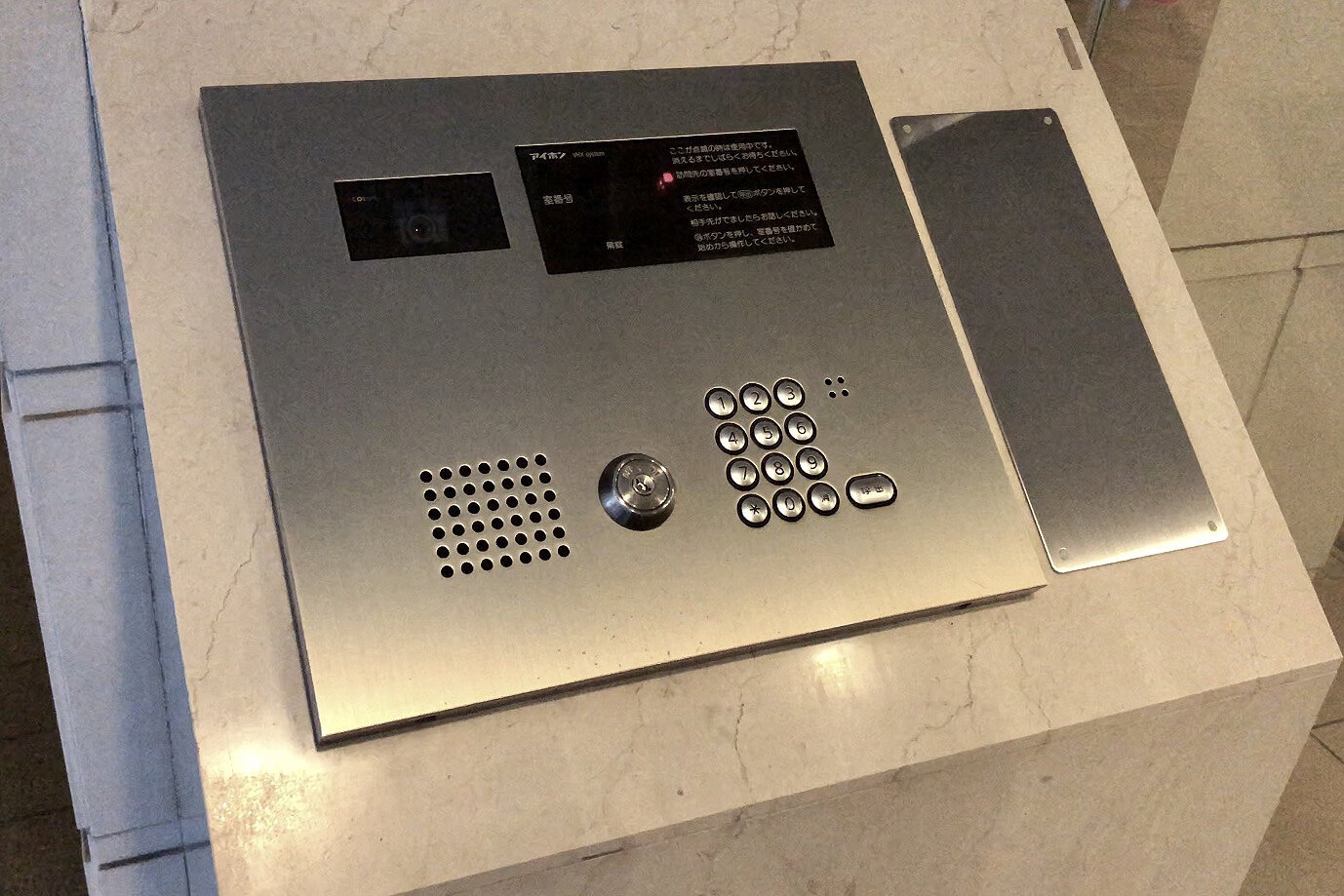
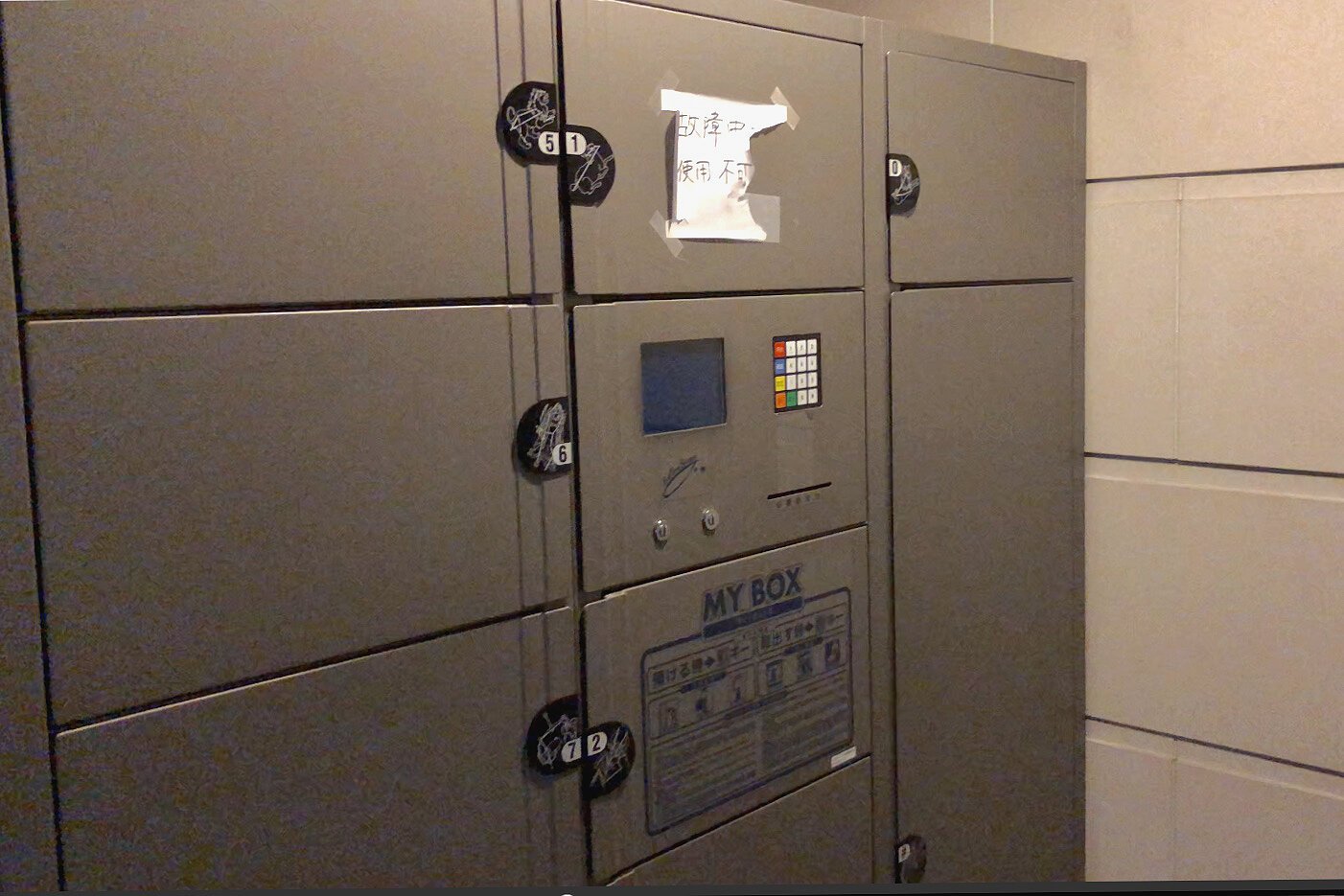
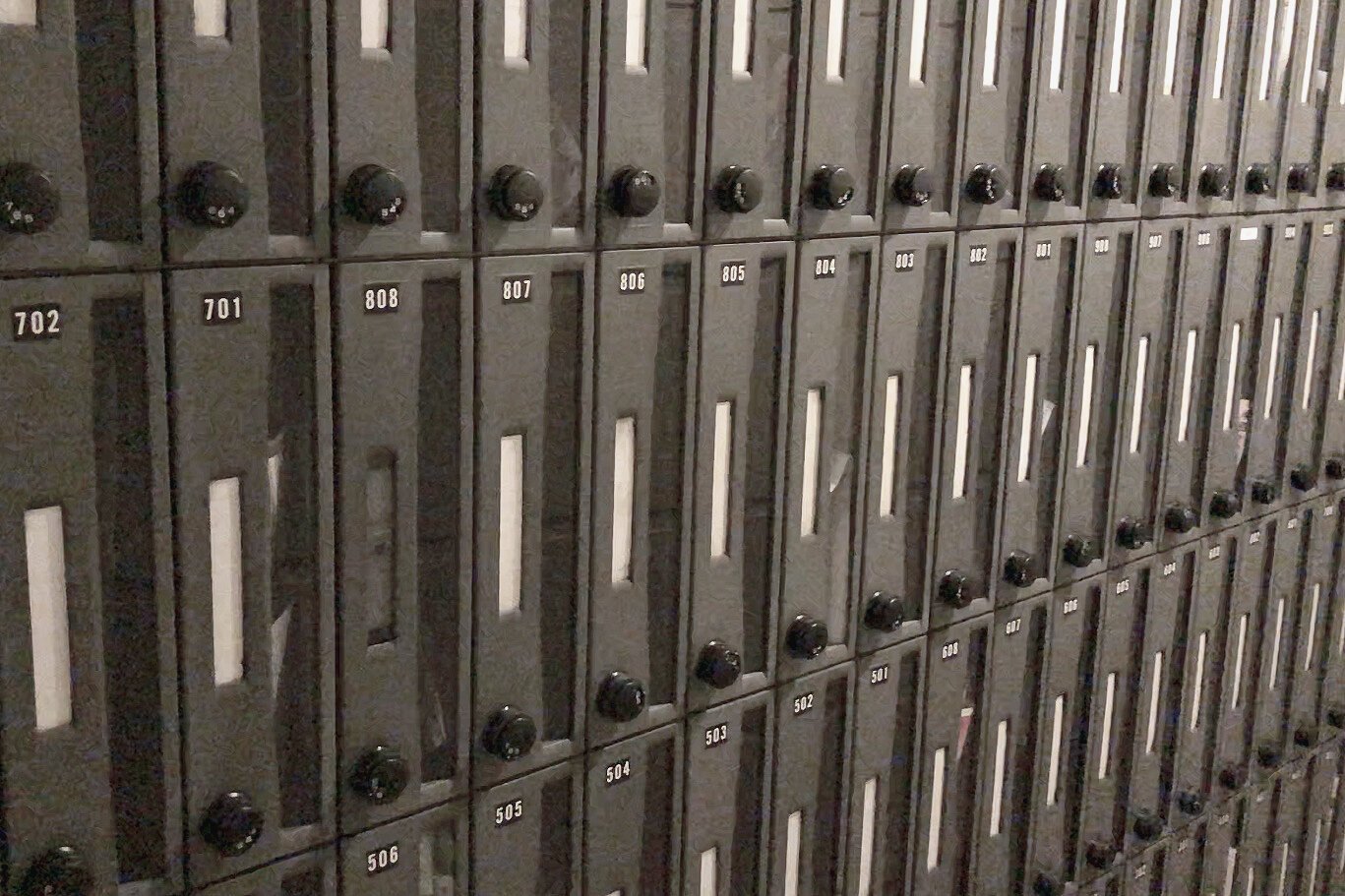
The building was next to an expressway, so the lower floors may have been a little on the noisy side. To the front of it was an office building of about equal height and another apartment building was on the opposite side of the expressway.
A woman would come and clean the apartment almost every morning so the common areas of the building were pretty well kept.
The apartment
My apartment was classified in Japan as a 1K, which means 1 room and a kitchen. It’s basically a simple studio. 1Ks are very common in Japan as living with non-family roommates isn’t typical, traditionally speaking.
Key features
24 sq. m (258 sq. ft.)
Stove with 2 gas burners
Bathroom with shower, tub
Washing machine hookup
1 concrete “designer” wall
Balcony with half view of Shinjuku
Sliding door with double-paned glass and invisible retracting screen
Higher than typical ceiling, concrete
Fees and costs
The monthly rent totaled to 95,000 JPY or about $950 USD. This included the management and service fee of 7,000 JPY ($70). When looking at the monthly costs, it’s pretty reasonable considering the size and density of the city, and quality of the apartment itself.
The initial costs, however, were a bit high.
Initial costs
While exact costs may vary depending on the rental agency, it is typical that there will be a deposit and “key money” amongst a few other smaller fees. The key money is what was a bit different from any rental experience that I had.
Poorly explained to me as a non-refundable “thank you” fee to the property owner for letting me rent, it’s paid at the beginning of each contract term. This means that you’ll pay it again if you choose to stay at the location and renew for another 2 years. Personally, I think it’s a ridiculous fee but that’s the norm in Japan.
Another fee I was charged was a cleaning fee that they used when I moved out.
My initial moving-in expenses were something like this:
Deposit: $950 (1-month’s rent)
Key/thank you money: $950
1st month’s rent: $950
Cleaning fee: $385
Key fee: $185
Insurance: ~$120 (1/year)
Debt collector fee: ~$100 (1/term)
Total: $3,640 (approx.)
Utilities
The rent didn’t include any utilities.
My monthly utility bills on average were something like this:
Electricity: $30-65 (depending on season)
Gas: $25
Sewer & Water: $30 (once every 3 months)
Internet: $45
Total: $110-$145/month (approx.)
This may total to more than a lot of other cities around the world. However, to get to live in one of the best cities in the world, a huge one at that, in my own place with my own bathroom and washing machine and everything, to me, was worth it.
Keep in touch:
How I Found My First Apartment in Tokyo
The process I went through to move to Tokyo and find an apartment to live in.
I moved to Tokyo in 2014, a huge mega city of more than 13 million in its central area.
This was the first time I would hunt for a place to live in Japan myself. I lived in a 2-bedroom apartment when I worked in Fukuoka prefecture but it wasn’t one I picked out for myself.
Finding an apartment in Tokyo was, of course, a bit different from my experiences finding ones in Los Angeles and San Francisco.
DIFFERENCES & DIFFICULTIES:
Residency/visa issues - Because non-Japanese don’t have typical paperwork like a koseki (family registry) and jūminhyō (official address registration), it’s difficult to run a background check. It’s unclear how you’re able to live in Japan, what your job situation is, how long you’ll be in the country, if they can collect if costs are unpaid, etc.
Communication hurdles - There are very tedious documents and requirements, and many agents in the process aren’t capable of any language besides Japanese.
Non-Japanese restrictions - Many buildings aren’t open to non-Japanese citizens due to reasons such as inability to communicate in emergencies, incompatible behaviors, previous bad experiences or simple stereotyping by the owner or tenants.
Agency-centric - Almost all rentals are managed and rented out by agencies rather than a landlord managing their properties themselves, so there’s automatically 4 parties involved in which you have to deal with: The rental agency, property owner, credit verification company and insurance company.
Luckily my company helped me with the move. I had a couple of weeks or so to find an apartment, a Japanese colleague came with me and my company vouched for me to help with any potential residency hurdles.
1. CONDUCT AN INITIAL SEARCH ONLINE
One of Japan’s largest residential developers, Sekisui House, was a client of ours and they just had started their rental platform, Sha Maison [J]. Like most apartment search sites, they give the option to search by factors like price, area, train line, train station, walking time from the station, size, etc.
Other search sites include SUUMO, LIFULL HOME’S [J], Good Rooms [J], Village House and Oak House, with the last two being the most foreigner-friendly.
At the time, I was relatively unfamiliar with areas in Tokyo besides the major hubs and tourist spots, so I didn’t have much of an idea about where to actually live.
The things I cared about in my search were:
West side of Tokyo (I was concerned about being too close to the ocean)
1K (Studio)
Had a balcony
1 transfer or less to/from work
Ideally within a 7 minute walk from the station
Less than 100,000円 (~$1,000 USD)/month
Just as a note, Japanese tend to be particular about things like auto-lock (building security system), bathtub, and having the toilet separate from the bathroom.
After finding a couple of apartments I was interested in, we put in a request.
2. WORK WITH THE RENTAL AGENCY
Sekisui House and Sha Maison are tied to one main agency: MAST [J]. We went to one of their locations to discuss what I found.
Unfortunately my first choice, a studio in the Kagurazaka area, had just been taken. They went through a list of available rentals (they had a lot more than what was listed on the site) and I picked out 4 available units that best matched what I wanted.
The 4 choices were 1K studios in Asagaya, Higashi-Nakano, Shimotakaido and Gotanda. Over the course of 2 days, an agent met us and we went to take a look at them. I narrowed my choices down to the apartments in Shimotakaido and Gotanda before picking the prior.
Luckily I moved in September. During peak moving season (February-April because it’s when schools graduate, job relocations happen and work contracts start and end), you have to be lucky and extremely fast to get a decent place as it’s very competitive.
3. COMPLETE ALL THE PAPERWORK
Once you decide you want a place, it’s not guaranteed that you’ll get it. The agency needs to check your credibility. As mentioned, they use another agency to do this.
HOW CREDIT IS CHECKED
In the US, credit is often checked by running your social security number. Japan implemented a similar “My Number” system a few years ago but as of right now in 2019, it’s basically meaningless as there’s no system on the backend that connects people’s information.
Credit is checked by methods such as confirming the company you work for, how long it’s been around, its capital and your position there. Definitely different.
JAPANESE DOCUMENTS AND FORMS
The paperwork is tedious and completely filled out by hand in Japanese. It’s often not prepared and printed out so that all you have to do is check the boxes, sign and date. It’s multiple copies where you have to write basically everything out by hand over and over again, and stamp them using a hanko (Japanese name stamp which is also required).
To be honest, if I didn’t have my Japanese colleague’s help, I probably wouldn’t have been able to do it on my own.
There’s a high chance that this process will take multiple trips and you’ll be running errands gathering all the necessary forms needed. That’s how it was for me.
4. MOVING IN
An agent met me in front of the building on my move-in date and handed me the keys, paperwork and contacts for questions or maintenance needs.
UTILITIES AND APPLIANCES
Unlike a lot of rentals in the US, apartment rentals in Japan come with nothing more than the room with light bulbs in the fixtures. Refrigerator, washing machine and any other appliances or furniture that you may need will have to be purchased on your own.
You will also have to contact utility companies to either connect to you apartment or put the account in your name. Electricity, water & sewer, gas and internet are the typical utilities.
The first few days were hard. My things hadn’t arrived yet so I was living out of a suitcase. I bought a cheap blanket and a towel, and slept on the hard floor with no curtains or anything.
I did better on my next move, but this was my first experiencing finding an apartment to move to Tokyo.
KEEP IN TOUCH
SHARE
A Snowy Winter Day in Tokyo
Capturing scenes from a snowy day in Tokyo.
It rarely snows heavily in Tokyo. In my three years living in the city, there's been an average of one or two days per year where it really comes down.
This year, I made sure to grab my camera and take some shots on the way home and around my neighborhood.
A couple shares an umbrella under the snow near Ochanomizu.
A Keio line train departs Sasazuka station bound for Hashimoto.
A Kuroneko Yamato delivery man delivering packages on a bicycle in the thick snow in Setagaya.
A taxi navigates a narrow street in Setagaya.



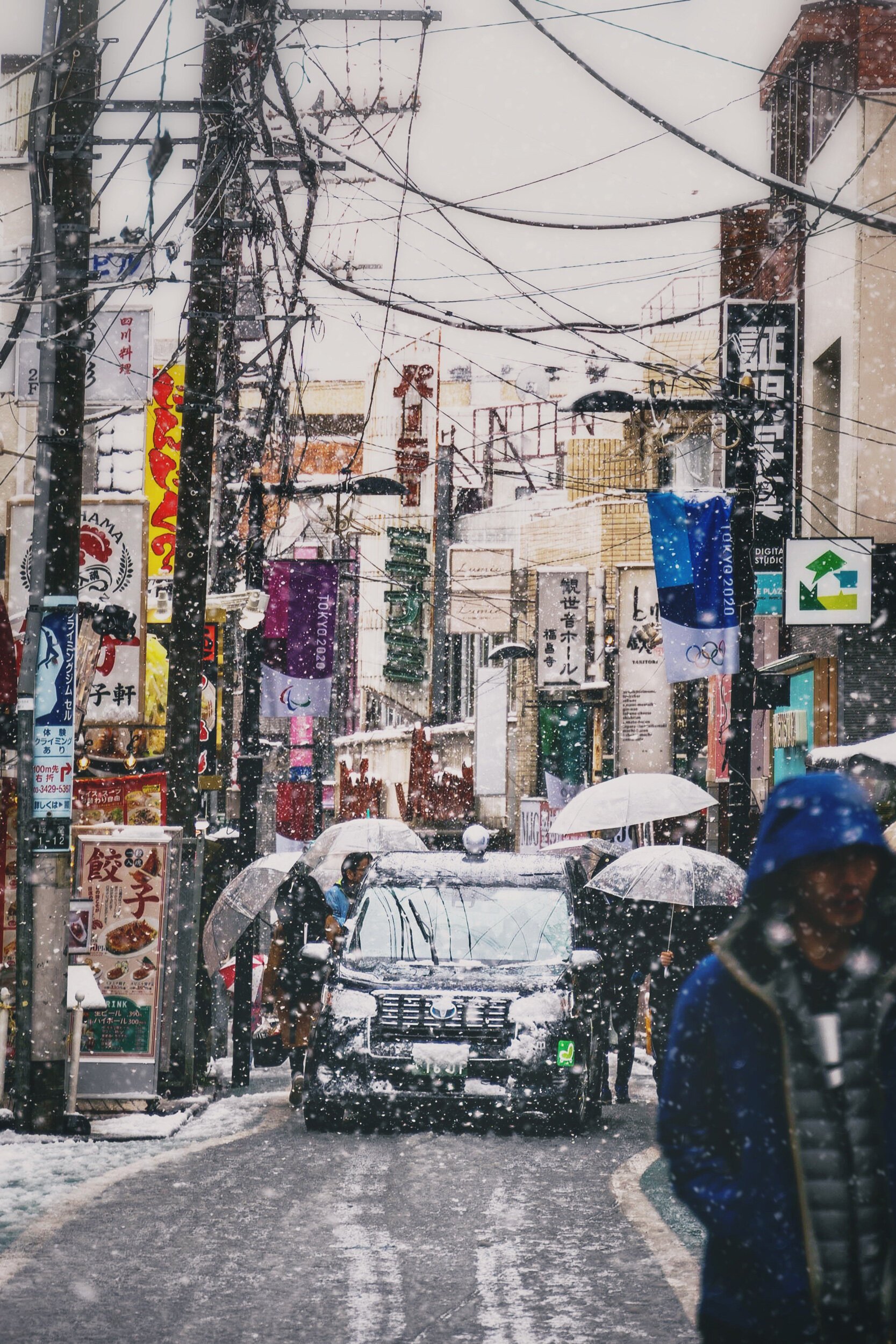


























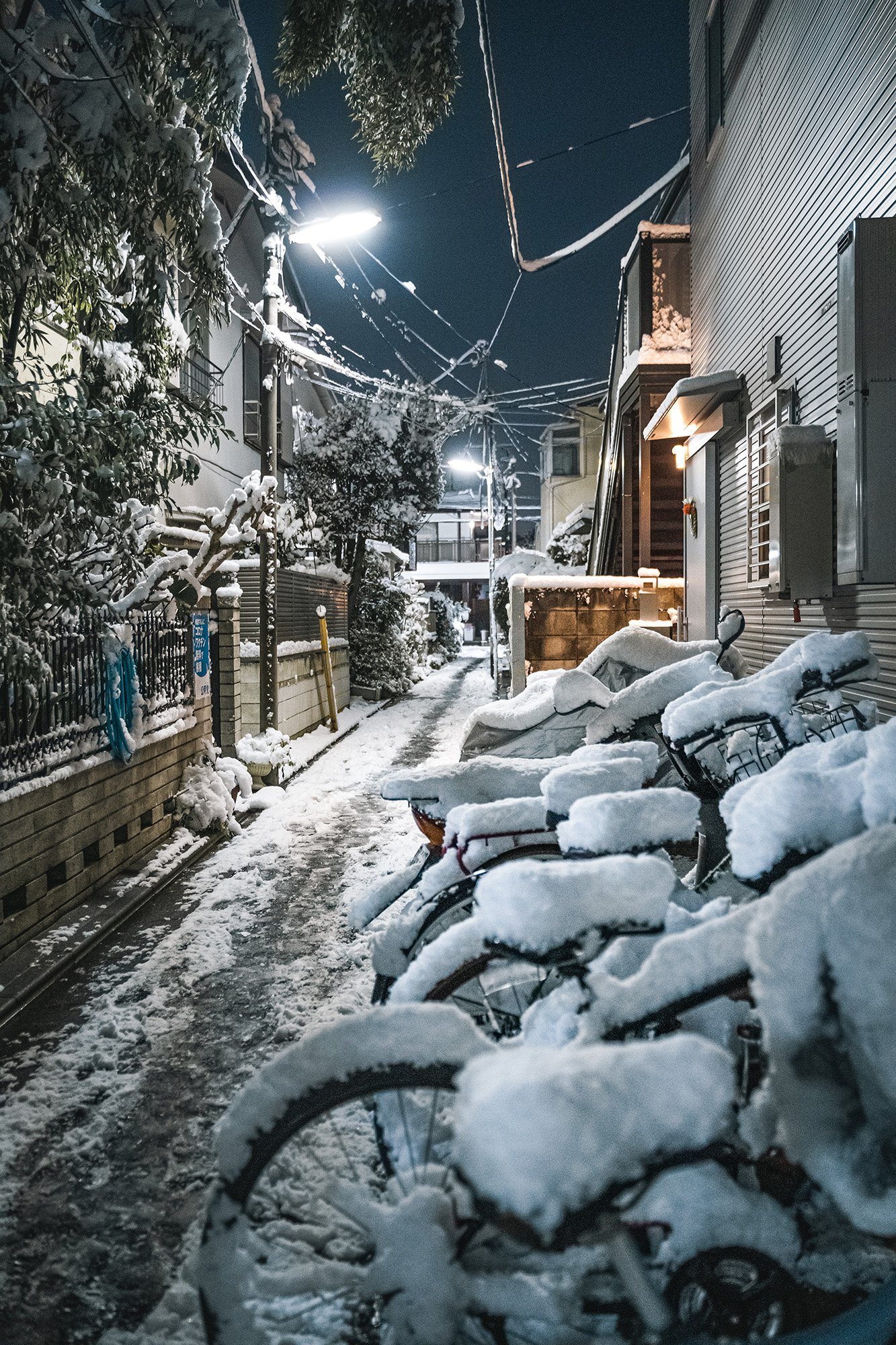


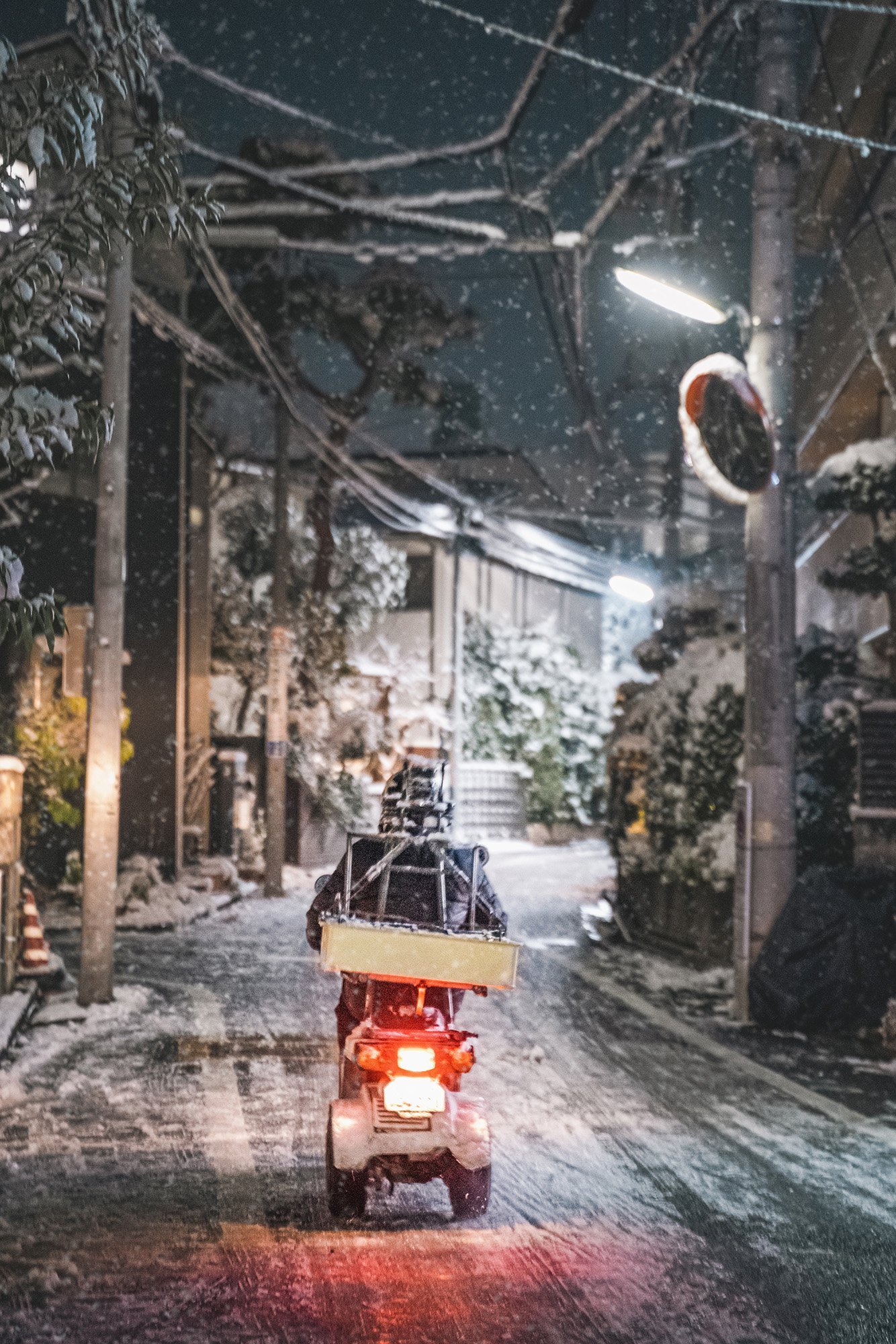



















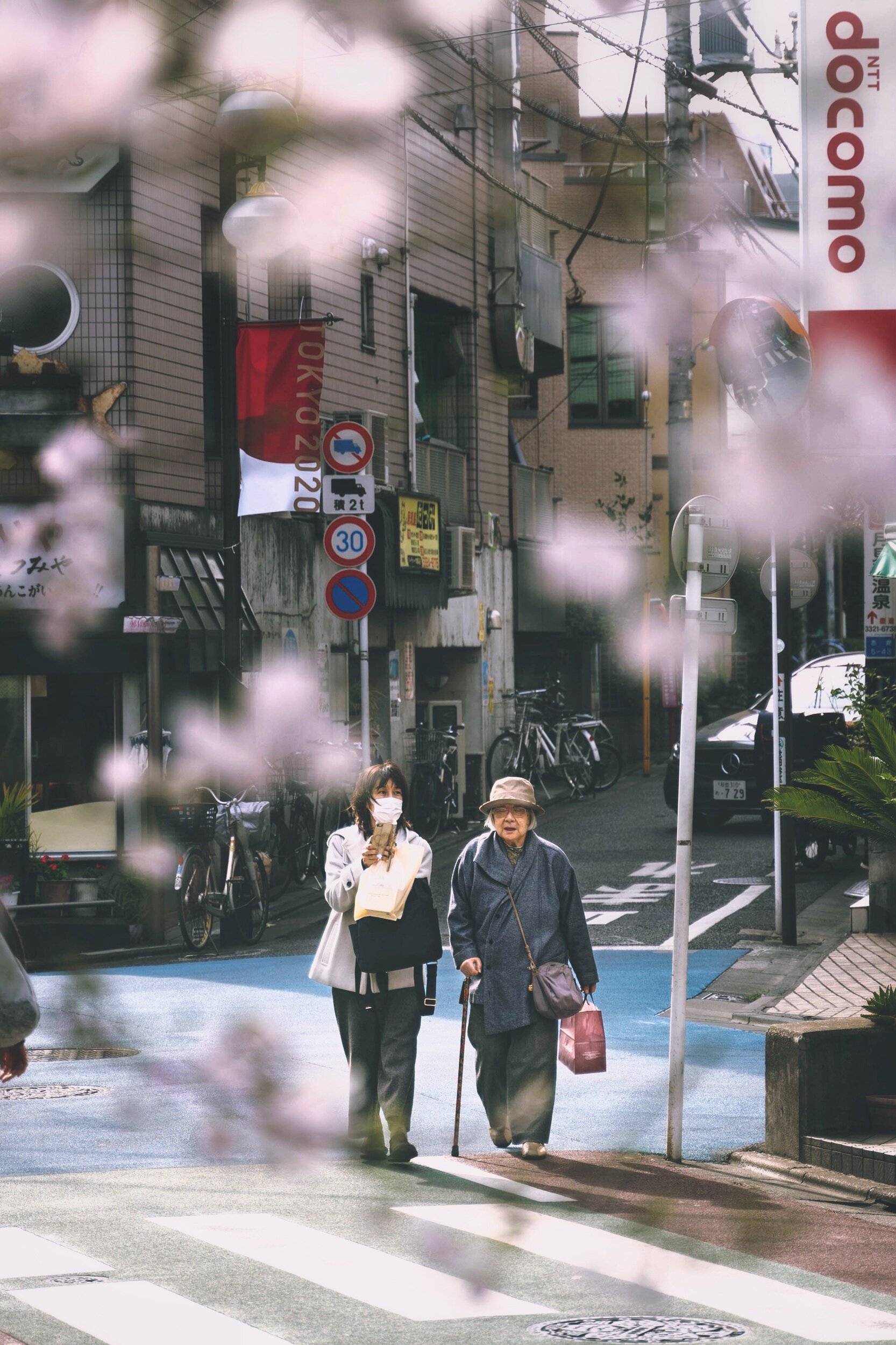











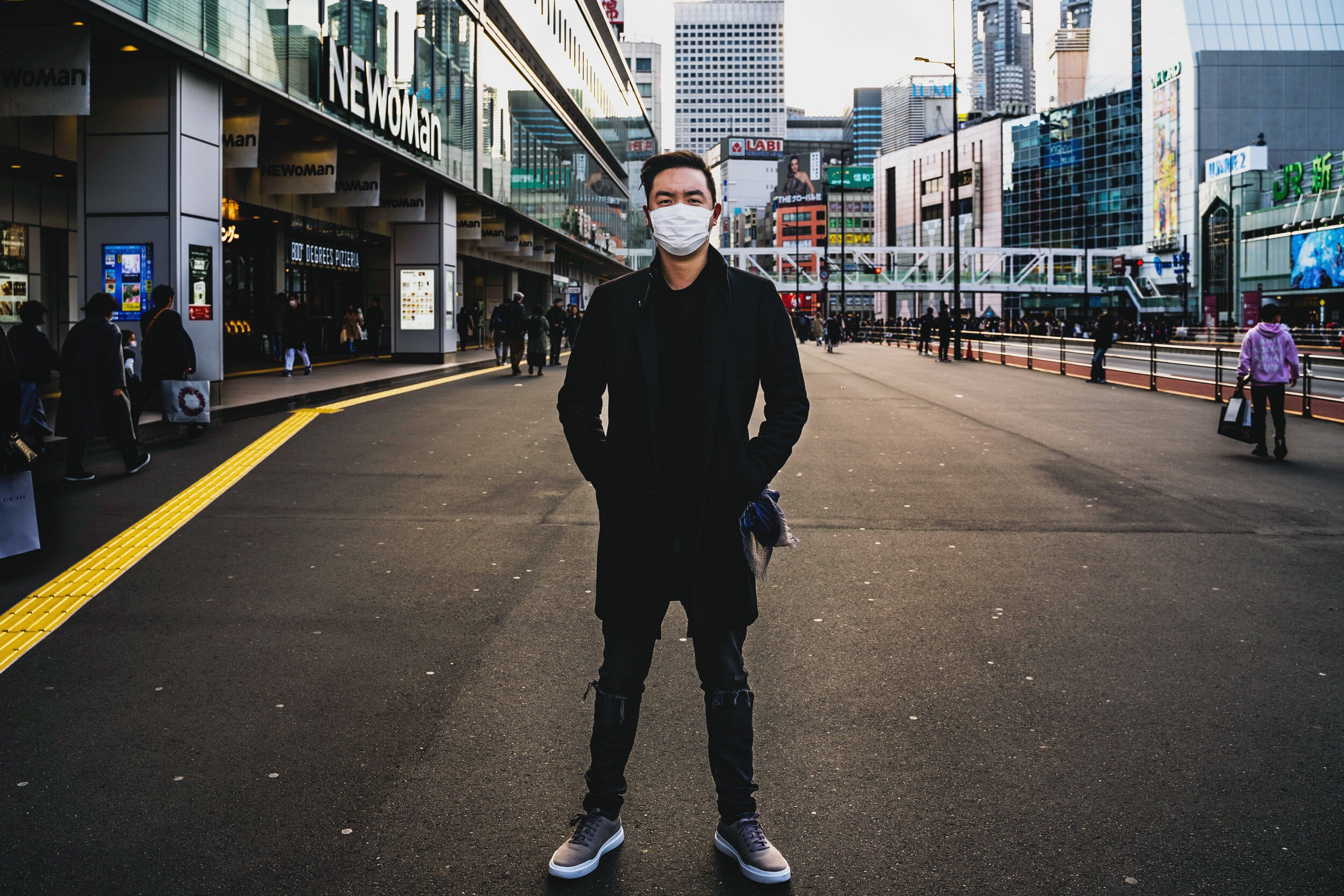





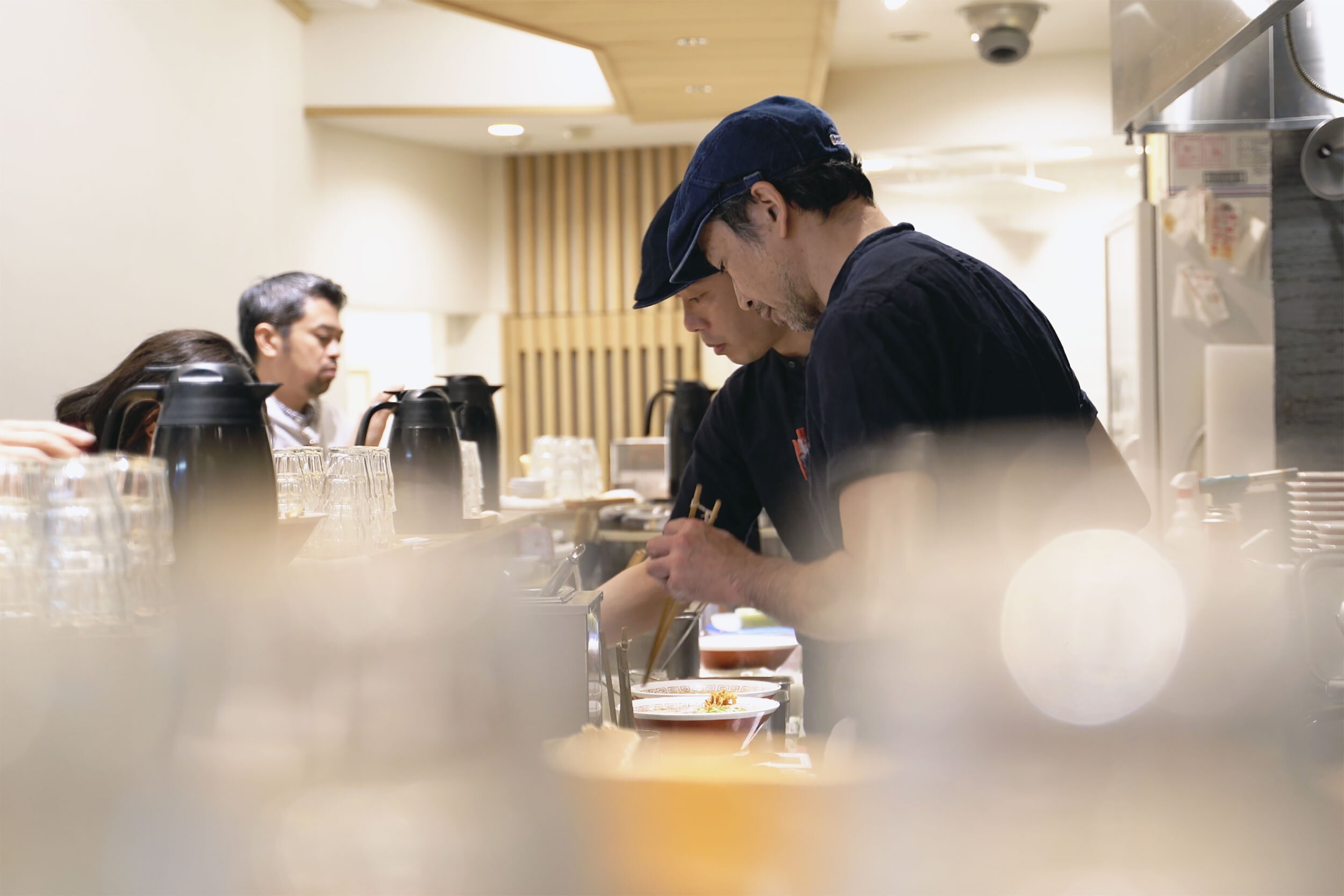





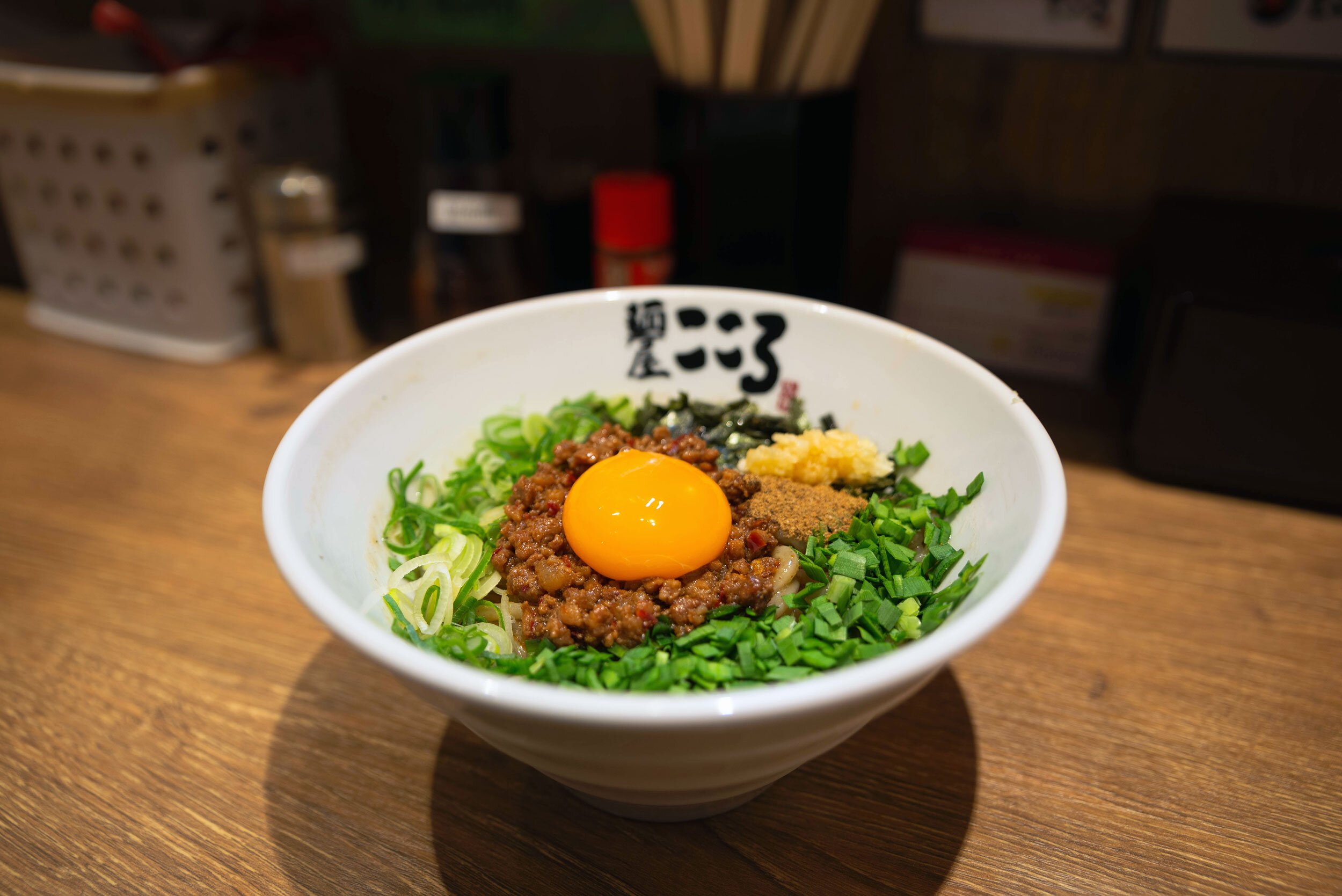


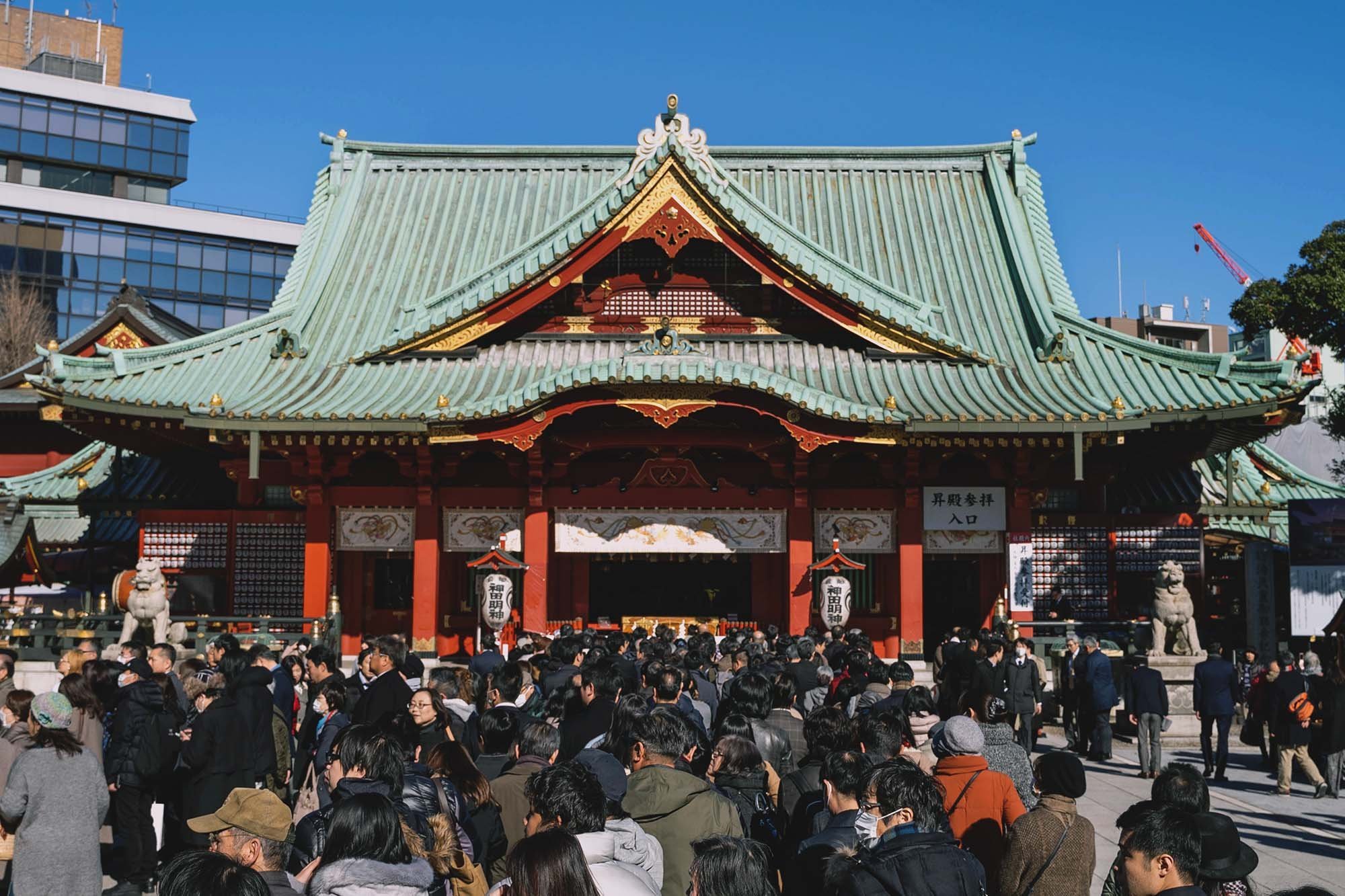









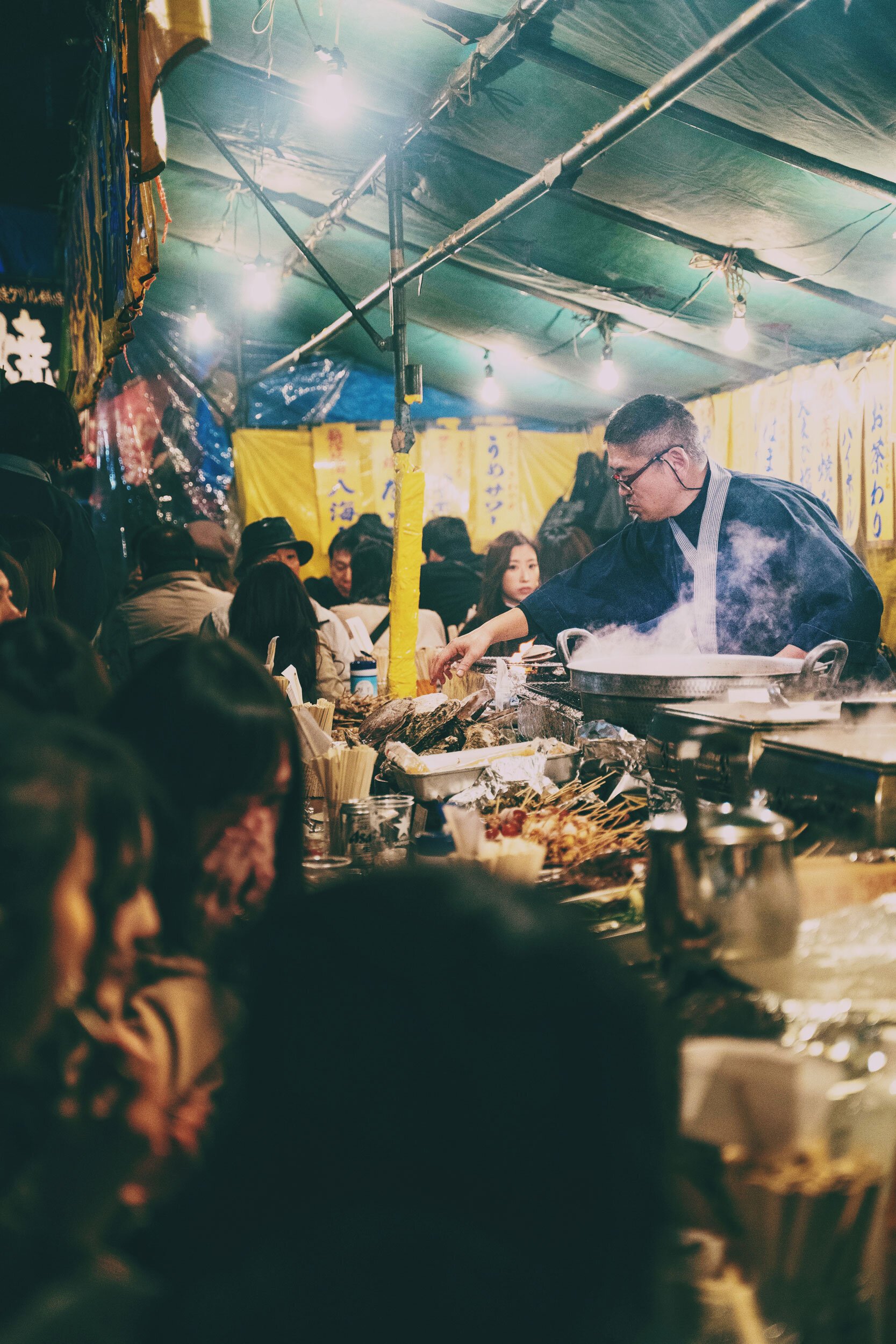













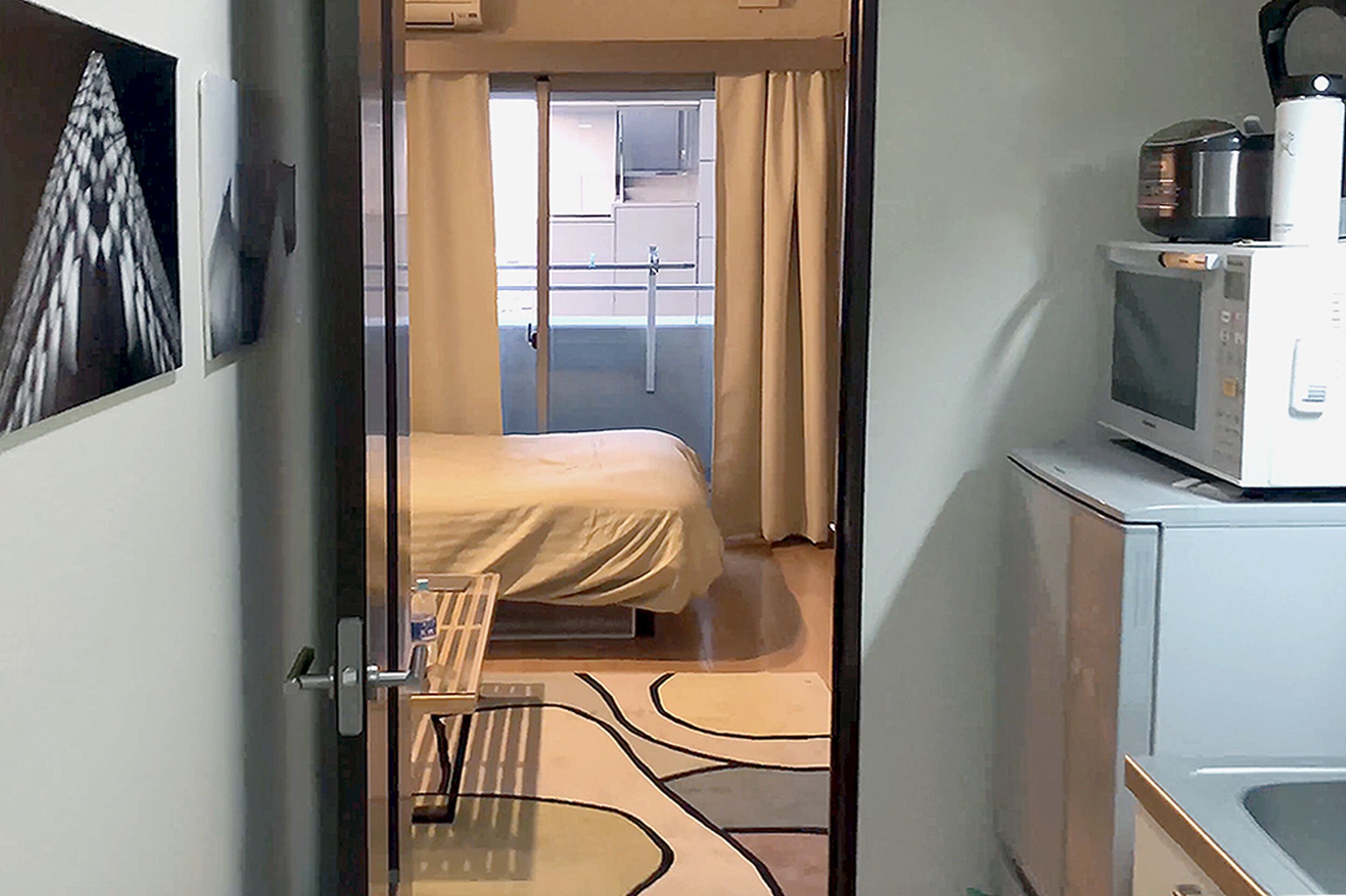





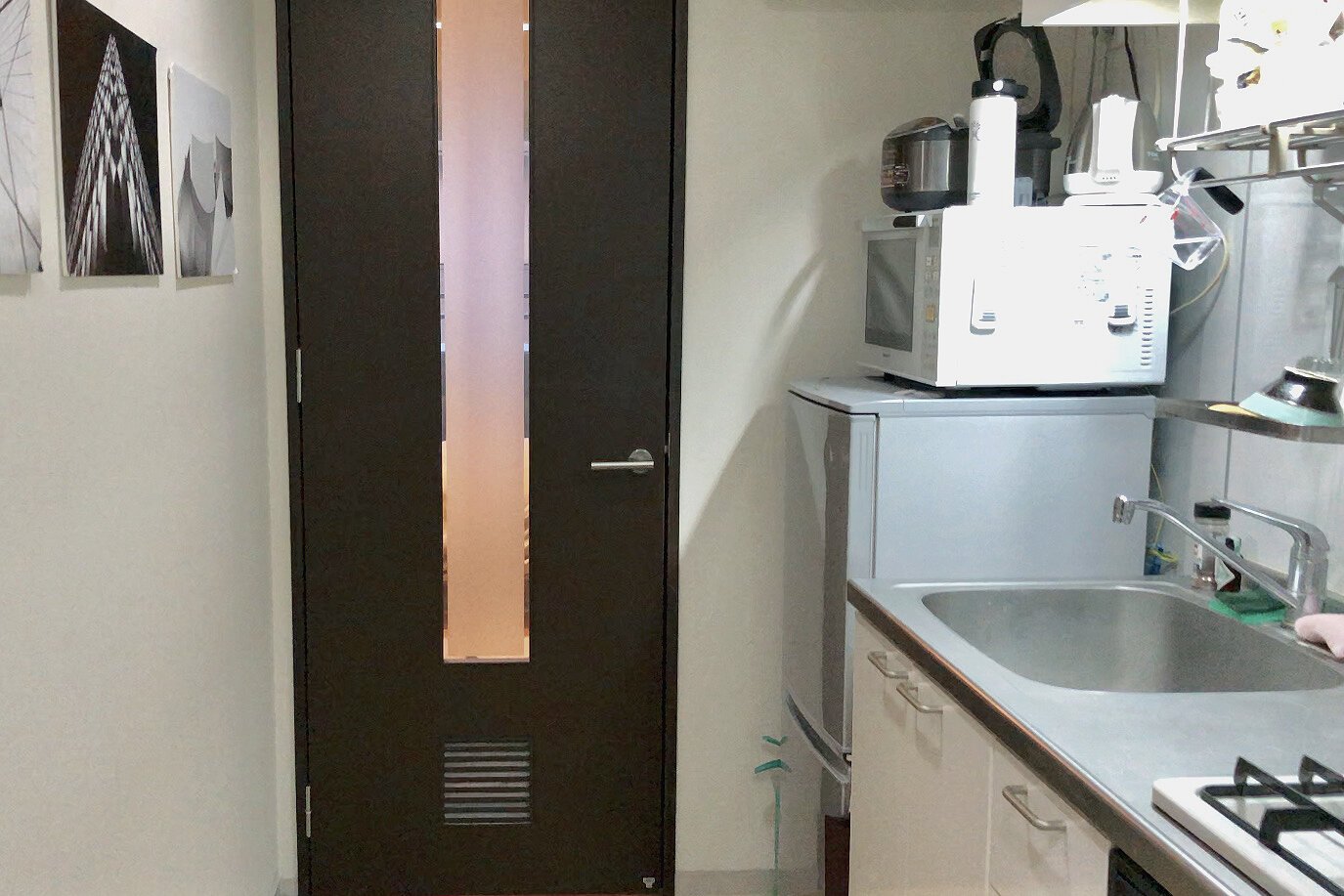












![A Keio train headed for Hashimoto pulls into Shimotakaido station. [BUY PRINT]](https://images.squarespace-cdn.com/content/v1/63f8b23b0626755198127ae3/1677548015262-D95YXLWFW7GO99XMHMWM/shimotakaido-snow-train-01B-web.jpg)
![A man makes his way home through the snow on his bicycle in Shimotakaido, Setagaya. [BUY PRINT]](https://images.squarespace-cdn.com/content/v1/63f8b23b0626755198127ae3/1677548018452-HHRYRHAWR8UVSJJTUDFB/shimotakaido-snow-bicycle-01C-web.jpg)

Here’s how Japanese in Japan and Japanese-Americans in Hawaii celebrate Japanese New Year’s differently.